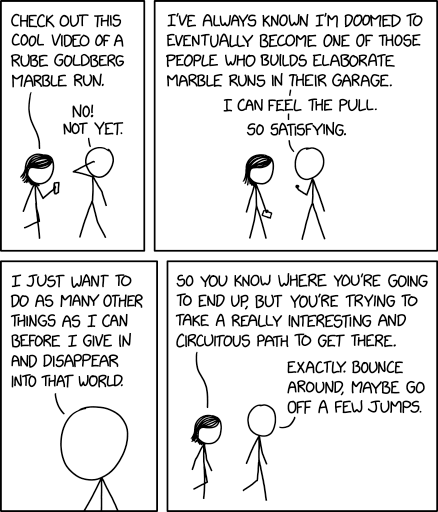A Rube Goldberg machine is a fancifully complex system (either real or imagined), which makes use of an overly elaborate chain of actions. The name comes from an American cartoonist who was one of several people who became famous for depicting convoluted and outlandish processes for accomplishing simple tasks.
There's a long history of people building actual contraptions along these lines. Such devices are almost never intended for practical purposes, but exist entirely for entertainment, and as an exercise in building complex and carefully planned systems. This has become particularly common in the internet age, as videos of particularly interesting examples can gain popularity online. The most common category of these systems is probably the marble run (also known as a rolling ball sculpture), in which the goal of the system is to move one or more balls or marbles from the beginning of the arrangement to the end in interesting ways. This contrasts to the domino run where motions are transferred by many intermediate pieces painstakingly arranged, although both aspects are commonly combined in such contrivances.
When Megan tries to show Cueball an example of such a video, he refuses, not because he lacks interest, but because of how he predicts it will impact him. Cueball (likely as a stand-in for Randall), has sufficiently strong interest in things like designing, building and engineering complexity that he's certain he will eventually adopt building such systems as a hobby, and that it will dominate his time and attention. Accordingly, he appears to be deliberately delaying his exposure to them so that he can continue to pursue other hobbies, with the assumption that he will eventually succumb to this one. Randall foresees the amount of time he might use if he first began trying to construct his ideas into a marble run.
Megan responds that he knows where he's going, but is taking "a really interesting and circuitous path" to get there. This draws a parallel between the type of systems he's avoiding and his approach to life more generally, which Cueball expands upon by suggesting he would do some of the things a marble typically would in a marble run.
The title text mentions specific ideas Cueball plans to incorporate into such a set-up.
A Galton board is a device that distributes falling balls into a normal distribution. Its design is similar to those used in pachinko-style games.
A Ranque-Hilsch vortex tube is a device for separating compressed gas into hot and cold streams. While such a device isn't directly applicable to marbles, one can imagine using the principle to separate a stream of marbles based on speed.
Pinball bouncers are properly supposed to be the Bumpers in Pinball machines. In Randall's marble run there will be a compartment where the walls are lined with these bumpers. Supposedly there will be many marbles on the floor of this segment of the run, which will hit these bumpers and get a kick so they will move fast and randomly around the compartment, which is where the Demon comes in.
Maxwell's Demon is a thought experiment by James Clerk Maxwell which would violate the Second Law of Thermodynamics. Maxwell proposed that, if a container of air was separated by a divider, with a door that allowed only one molecule through at a time, and a theoretical "demon" were to control the door to sort high-energy atoms into one side and low-energy atoms into the other, the two sides would develop a temperature difference with no energy input. While such a system wouldn't actually be possible without energy input, it remains a compelling thought experiment.
Randall's version of this apparently involves the marbles bouncing around inside the bouncer-lined compartment, with an automated system to divert the fastest moving marbles into one side, and the slowest moving into the other, presumably to output higher velocity balls into one subsequent part of the arrangement, and slower ones into another. As these are macroscopic scales this would not be impossible, just really difficult.
Knowing Randall and his fans, some might design something using his ideas from this comic. In 2916: Machine, the readers built such machines.
